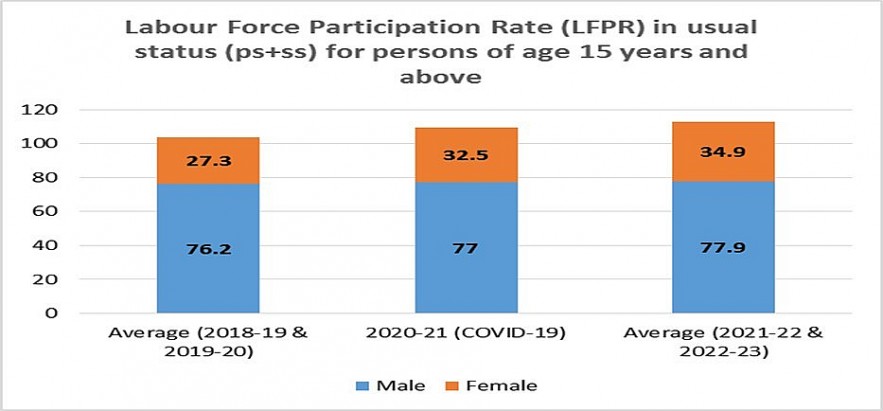Strong economy fuels labor market in India
The labor market conditions in India have shown significant improvement through the increase in labor force participation rate and decrease in unemployment rate. The increased capital expenditure has played a crucial role in improving the labor market scenario by generating more productive jobs. Skill development initiatives and vocational training programs have contributed to upgrading and re-skilling the workforce in India. The capital expenditure in India has increased manifold during the last 10 years, from Rs. 1.9 Lac crore in 2013-14 to Rs. 9.5 lac crore in 2023-24. The tremendous increase in capital expenditure is creating employment avenues for skilled, semi-skilled and un-skilled workforce in
The labor force participation rate (LFPR) for males, females, and all persons (15 years of age and older) in India has increased from 50% 2018–19 to 58% in 2022–23. The LFPR of males was 75.5% in 2018-19 and it has increased to 78.5% in 2022–23. While for females, the rate has increased from 24.5% in 2018–19 to 37% in 2022–23.
LFPR for persons of age 15 years and above in India (%)
 |
| Source : Annual Report : Periodic Labour Force Survey (PLFS) JULY 2022 - JUNE 2023 |
The unemployment rate in usual status ((principal status and the subsidiary status) reveals significantly positive results in India. The unemployment rate for males, females, and all persons (15 years of age and older) has been declined from 2018–19 to 2022–23. In 2018–19, the unemployment rate for males was 6%, and it dropped to 3.3% in 2022–23, while for females, the unemployment rate has decelerated from 5.2% in 2018–19 to 2.9% in 2022–23. Overall, the unemployment rate has declined from 5.8% in 2018–19 to 3.2% in 2022–23.
Unemployment rate in for persons of 15 years and above in India (%)
 |
According to the Periodic Labour Force Survey (PLFS) for January – March 2024, released on 15th May 2024 by Ministry of Statistics and Programme Implementation, Government of India, the urban unemployment rate has been declined to 6.7% in Q4FY2024 from 6.8% in Q4FY2023 for persons of age 15 years and above. This improvement in the employment scenario is reflective of the strong economy and its ability to generate more job opportunities. The labour force participation rate (LFPR) in urban areas has also observed a positive shift, rising to 39.5% in Q4FY2024 from 38.1% in Q4FY2023, indicating an increase in the number of people actively seeking work in urban areas.
Furthermore, the worker population ratio (WPR) witnessed a significant rise, climbing to 36.9% in Q4FY24 from 35.6% in Q4FY23, suggesting that a higher proportion of the working-age population is now employed; suggesting a promising trend in the labor market, highlighting the efficacy of economic policies and employment creating strategies. Government’s prudent policies such as Make in India, Production Linked Scheme and a focus on sectors such as MSMEs in manufacturing, food processing and expansion in services sector activities, the employment landscape has expanded. The growing sectors are not only generating new jobs but also offering better quality employment with higher wages and improved working conditions.
This decline in unemployment is majorly attributed to the expanded industrial activity and the rise of new enterprises vis-à-vis start-ups along with the robust economic growth trajectory. The size of the economy has doubled from USD 1.8 trillion in 2013-14 to USD 3.7 trillion in 2023-24 and is expected to be USD 7 trillion by 2030; this large expansion in the scale of the economy will create tremendous avenues for employment creation in the country in the coming times.
The UN World Economic Situation and Prospects Report 2024 highlights that labor market indicators in India have shown significant improvement. This positive trend is attributed to robust economic growth and an increase in labor force participation. As economies worldwide recover from the impacts of the COVID-19 pandemic, more people are entering the workforce, and job opportunities are expanding in the growth promising countries.
According to the recent HSBC Flash India Composite Output Index, India's private sector activity surged in May 2024, marking the third strongest increase since July 2010, climbed to 61.7, with both manufacturing and services sectors showing robust expansion. New export orders reached their highest level since September 2014. Such optimism in the private sector is encouraging the business firms to expand their staffing levels in their respective business premises. The intensification of the capacity pressures is creating new avenues for deployment of workforce in the business premises.
Recently, India’s premier industry body PHDCCI projects India’s potential to create 10 crore jobs by 2030 on the back of booming economy, strong exports, robust financial markets and sustained domestic demand. The country’s vision for the Viksit Bharat alongwith infrastructure developments vis-à-vis consistently increased capital expenditure are revitalizing labor market and creating scope for new employment opportunities in the country.
In conclusion, higher labor force participation rates contribute to a more inclusive economic development in the country. As more individuals, including women and marginalized groups, join the workforce, it promotes greater economic equity and social cohesion. This inclusivity helps in reducing poverty and narrowing income disparities, fostering a more balanced and resilient economic structure. Going ahead, conducive environment for job creation will further intensify the skill development activities and strengthen India’s journey towards a Viksit Bharat by 2047.
